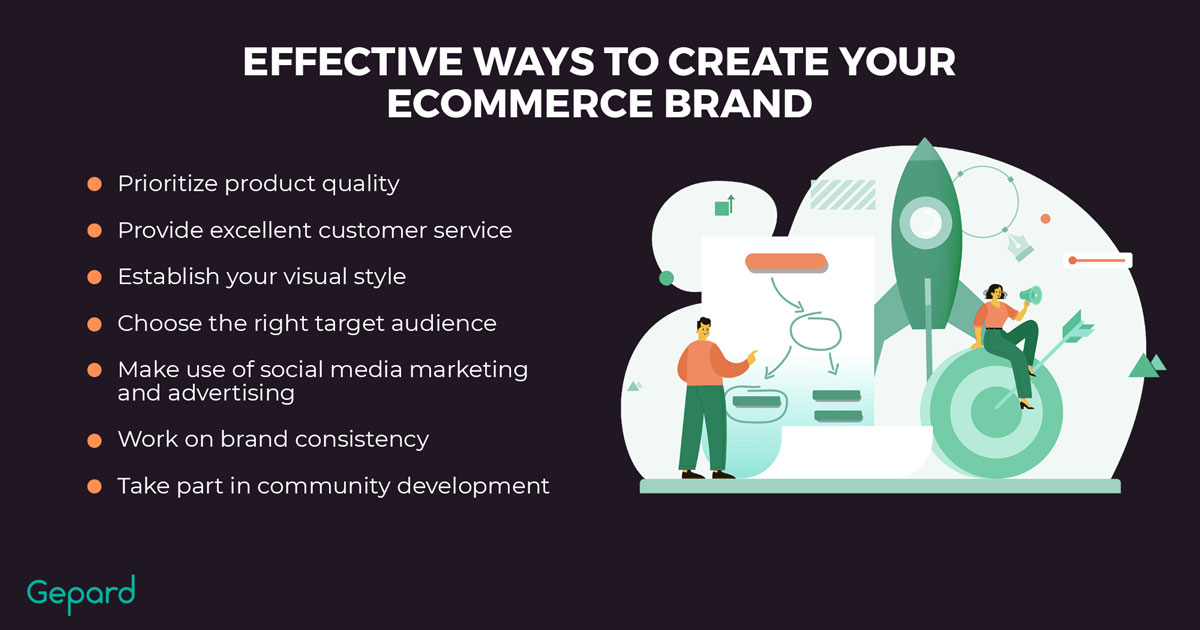How To Build A Strong eCommerce Brand
As witnessed presently, most customers prefer buying products and services from the comfort of their homes. For that reason, the marketplaces have been forced to shift their focus online by the development of apps and websites.
However, the competition is fierce. Product lines can go viral relatively quickly as new brands enter and dominate the industries. Again, buyers have no trouble switching relations from one brand to the next.
Building an eCommerce brand could appear to be a challenging and complicated task amid all this competition, but it is quite achievable. So, all things put into consideration, how do you create (or recreate) a successful eCommerce brand?
We’ve outlined some sure-fire strategies for growing your eCommerce business into a successful brand.
eCommerce Business VS eCommerce Brand
Any company that buys and sells commodities or services using the internet is considered an eCommerce business. To complete these online transactions, eCommerce businesses are digitized to transfer funds and information.
On the other hand, an eCommerce brand is a company’s distinct, one-of-a-kind personality. It is mainly based on peoples’ views and conversations about your business and its identity through direct or indirect interactions.
Do you know why Apple and Starbucks are two of the world’s most well-known and globally recognized companies, which most people desire to interact with? They are brands, not just businesses.
Your eCommerce brand is more than just your name, logo, and catchy slogan. People will connect with your eCommerce brand when you evoke high passion and enthusiasm in engagements and conversations.

Why Is It Necessary To Build An eCommerce Brand?
eCommerce branding is critical not only for making a good first impression but also for the overall success of your business. It will also provide your company with a competitive advantage, and clients will frequently choose you over competitors.
When consumers trust and like your brand, they are more likely to be regular customers and continue with you over time. In the long term, your branding, combined with your customer service, will help you cement your position in the crowded eCommerce market.
What Are The Four V’s That Make A Brand Successful?
To create and define your eCommerce brand, you must undertake research. The four V’s of a successful brand are visuals, voice, value, and vision. Let’s discuss them in detail:
- Vision
A clear vision must steer your business for it to be appealing to customers. Without a doubt, your brand’s vision is what it strives for. It is meaningful rather than monetary. It is the motivation behind the launch of your eCommerce brand.
- Voice
The voice of a brand is its main message and how the message is delivered. The way customers perceive and experience the brand is described in a few words.
This varies based on your target market and objectives, you could be: comical, authoritative, professional, friendly, or complex. To avoid confusing your target market, your voice must be captivating and consistent.
- Visuals
These are visible symbols connected with your company. A brand’s visuals may focus its attention on the graphics or the design of a brand only after the voice is clear. They include:
1. Logo
2. Fonts
3. Color
It’s critical to match visuals to the messaging to reinforce the brand message while also catering to various types of customer learning styles.
Read more about the importance of visual assets for your eCommerce business:
Creating A Brand Logo
Your logo design is a distinct mark, icon, or image that serves as the face of your company. It is an unspoken representation of your brand to both known and unknown customers.
- Values
The things that are essential to you and your audience are called values. Your company’s principles act as a compass, directing everything you do and how you do it. Understanding and satisfying potential customers’ most pressing needs provide value.
Before consumers can spend a lot of money on something, the brand must offer a strong desire for it. Brands must also be aware of the competitive positioning of their product or service.

7 Effective Ways To Create Your eCommerce Brand
We’ve detailed seven techniques to help you build your eCommerce brand in this guide. They are essential for any eCommerce business that wants to stand out from the crowd.
1. Prioritize Product Quality
Truth be told, consumers today will not accept substandard products! Most popular and well-known eCommerce firms are those making and selling high-quality goods and services.
If you have a new eCommerce brand, you can choose to concentrate on a single high-quality product. This is because it’s easier to pay greater focus to the general quality and performance of your product.
Later, you can gradually start expanding into other types of products to service the same demographic and niche. This is once you’ve perfected and successfully established one product and created a devoted following of clients.
The same goes for product data: it should be accurate, up-to-date, and easily accessible on multiple sales platforms. Creating compelling product content is one of the tasks that you can easily solve with a product information management solution like Gepard PIM that can serve as a single source of truth for an eCommerce business of any size.
2. Provide Excellent Customer Service
Customers are what make a company successful. Because you don’t have a business if you don’t have clients! Excellent customer service helps make it simple for customers to provide feedback. It allows you to know how your customers are thinking and what you can do to make their lives better.
Acting on consumer complaints will help your eCommerce brand identify where your eCommerce business is failing. Striving to improve your business and buyers’ experience is a good method to establish a great eCommerce brand.

3. Establish Your Visual Style
When it comes to creating your brand’s style, you’ll want something distinctive, memorable, and relevant to your brand. It should be guided by your company’s goal and consumer purchasing behavior.
Visuals are necessary for establishing a brand online because they are easier to understand and consume and also help with product branding. You want people to be able to tell who you are simply by looking at you.
Furthermore, buyers value authenticity in marketing. Your brand’s style must be consistent and reasonable. Pick a good style that represents your brand’s objective to deliver the best results.
4. Target Audience
Focusing on the right core demographic is critical to the success of any eCommerce business. You must precisely define your available and achievable market so that you can connect with their needs.
It’s tempting for a new eCommerce business to believe that everybody with a web connection is their consumer. Although optimistic it might not be realistic. To be successful at audience targeting, your eCommerce brand must first answer these 4 questions:
- Who is your target audience?
- Where can they be found?
- What obstacles do they face and what is the solution?
- What terms do you use in their searches?
5. Make Use Of Social Media Marketing And Advertising
Social media is a massive resource that is rapidly growing in popularity. There’s no better time for an eCommerce brand to take advantage of social media channels for brand development.
An eCommerce brand can create a social media presence that focuses on interaction and customer service. By encouraging customer engagement and responding to their inquiries your eCommerce brand will increase traffic hence more conversions.
Read more about the importance of social commerce for your omnichannel strategy:
Additionally, creating online marketing campaigns will spread awareness about your brand. These could be through Instagram ads, Facebook ads, live events, and influencers. And with these platforms being interconnected, information is passed on a much larger scale.
6. Brand Consistency
Your eCommerce brand should tell a single story and have its own consistent identity so that it can represent the brand effectively in its everyday operations. Developing style guides is a key step in ensuring uniformity across all channels.
With all the means brands can be represented, avoid using multiple styles or voices. They can undermine customer trust and can make your brand undifferentiated. Particularly on big eCommerce brands such as Amazon, where people buy since they trust the seller.
This implies that every email, social media message, and blog article communicates the same consistent brand identity. Not forgetting style guidelines that could include topics, tone of voice, design, the font used, website search, and more.
7. Take Part In Community Development
Customers appreciate and connect more with brands that are involved in charity and community work. Not just profits. As an eCommerce brand, you can choose to become a part of something bigger.
To find a cause to support, think about your brand’s principles, community needs, and charities that matter to your customers. You can choose to inform your clients of the percentage of your profit that is donated to a charity of your choice.
By doing this when people buy anything, they are also contributing to a good cause. In the long-term, your eCommerce brand will build a loyal army of customers and brand ambassadors. They’ll appreciate your efforts to better their lives and the lives of others.
Conclusion
Building a long-lasting eCommerce brand is a continual process that incorporates the style, engagement, and marketing of your eCommerce store. As a result, it can take a while for it to fully materialize and pay off handsomely in the future.
The above points will help you design an eCommerce brand that speaks to the needs and desires of your clients, whether your company is new or established. By appealing to your clients’ emotions, your branding approach will entice and drive them to buy.
As always, the best piece of advice anyone can give is to simply begin. Create a solid foundation, be willing to adapt, and put the client at the center of all you do. If you can do that you’ll have a better chance of building a strong brand for your eCommerce business.






